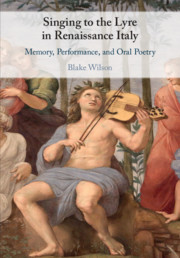Book contents
- Singing to the Lyre in Renaissance Italy
- Singing to the Lyre in Renaissance Italy
- Copyright page
- Contents
- Figures
- Tables
- Acknowledgments
- Abbreviations
- Introduction
- Part I The Canterino Tradition
- 1 Early History: Ioculatores and Giullari
- 2 The Trecento Canterino
- Excursus 1 Piazza San Martino: Performance, Place, and Audience in Florence
- 3 The Canterino in the Fifteenth Century
- Part II Cantare ad Lyram: The Humanist Tradition
- Bibliography
- Index
3 - The Canterino in the Fifteenth Century
from Part I - The Canterino Tradition
Published online by Cambridge University Press: 31 October 2019
- Singing to the Lyre in Renaissance Italy
- Singing to the Lyre in Renaissance Italy
- Copyright page
- Contents
- Figures
- Tables
- Acknowledgments
- Abbreviations
- Introduction
- Part I The Canterino Tradition
- 1 Early History: Ioculatores and Giullari
- 2 The Trecento Canterino
- Excursus 1 Piazza San Martino: Performance, Place, and Audience in Florence
- 3 The Canterino in the Fifteenth Century
- Part II Cantare ad Lyram: The Humanist Tradition
- Bibliography
- Index
Summary
The fifteenth century was the golden age of civic canterino activity, and Florence was its heart. Though two other centers for which evidence survives, Siena and Perugia, are also treated in this chapter, what these documents make clear is that, although capable canterini could still emerge elsewhere in Italy, Florence was the source from which other cities recruited. The rich Florentine archives make it possible to construct a detailed and nuanced view of canterino activity in the city, which thrived in Medici palaces, artisan workshops, piazzas, and the civic government in the Palazzo Vecchio. This chapter explores the careers and poetry of the most famous canterini of the day, Niccolò cieco d’Arezzo, Antonio di Guido, and Cristoforo Fiorentino (called L’Altissimo), and their relationship to Piazza San Martino during its highpoint as a performance venue. This chapter also explores classical memory technique as it came to be appropriated by the Florentine canterini, evidence of which are four vernacular memory treatises that can be linked directly to these singers. The contents of these treatises are summarized and explained with reference to the surviving poetry of the canterini, and as a means to understanding how poetic and musical improvisation worked.
Keywords
- Type
- Chapter
- Information
- Singing to the Lyre in Renaissance ItalyMemory, Performance, and Oral Poetry, pp. 102 - 176Publisher: Cambridge University PressPrint publication year: 2019

